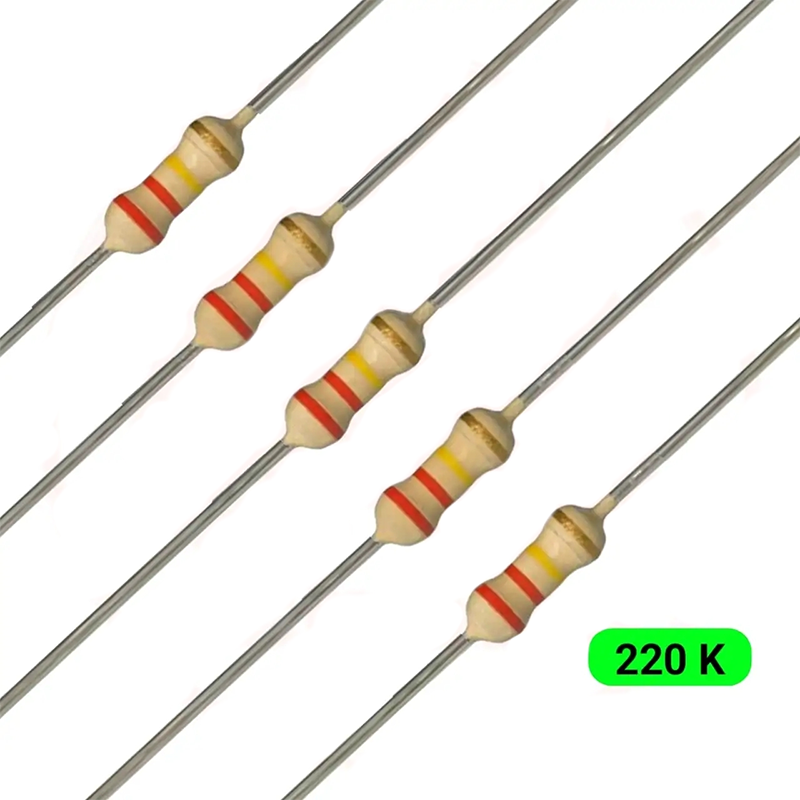
Five 4-band 220k resistors (Color: Red - Red - Orange - Golden)
In the realm of electronics, understanding resistor color codes is crucial. These tiny bands of color tell a story about each component's properties and functions within a circuit. One such commonly used component is the 220K Ohm resistor. This article will guide you through its unique color coding, helping you decode this seemingly complex system with ease. This article refers to IEC 60062:2016+A1:2019 Specification for name and marking codes of capacitors and resistors.
Catalog
Introduce 220kΩ Resistor
Introduce Resistor Color Code
How to Read 220k Ohm Resistor Color Code
5 Band 220k Ohm Resistor Color Code
6 Band 220k Ohm Resistor Color Code
220K Color Code Resistor Collection
Introduce 220kΩ Resistor
A 220kΩ resistor is a passive electronic component that offers resistance of 220,000 ohms (or 220 kilohms). It's primarily used for controlling the flow of electric current in an electronic circuit. The color bands on such a resistor typically read Red-Red-Black-Orange-Gold/Silver, representing its resistance value and tolerance. Gold signifies ±5% tolerance while silver indicates ±10%, meaning the actual resistance could vary within these ranges. Some resistors also have a sixth band indicating temperature coefficient.
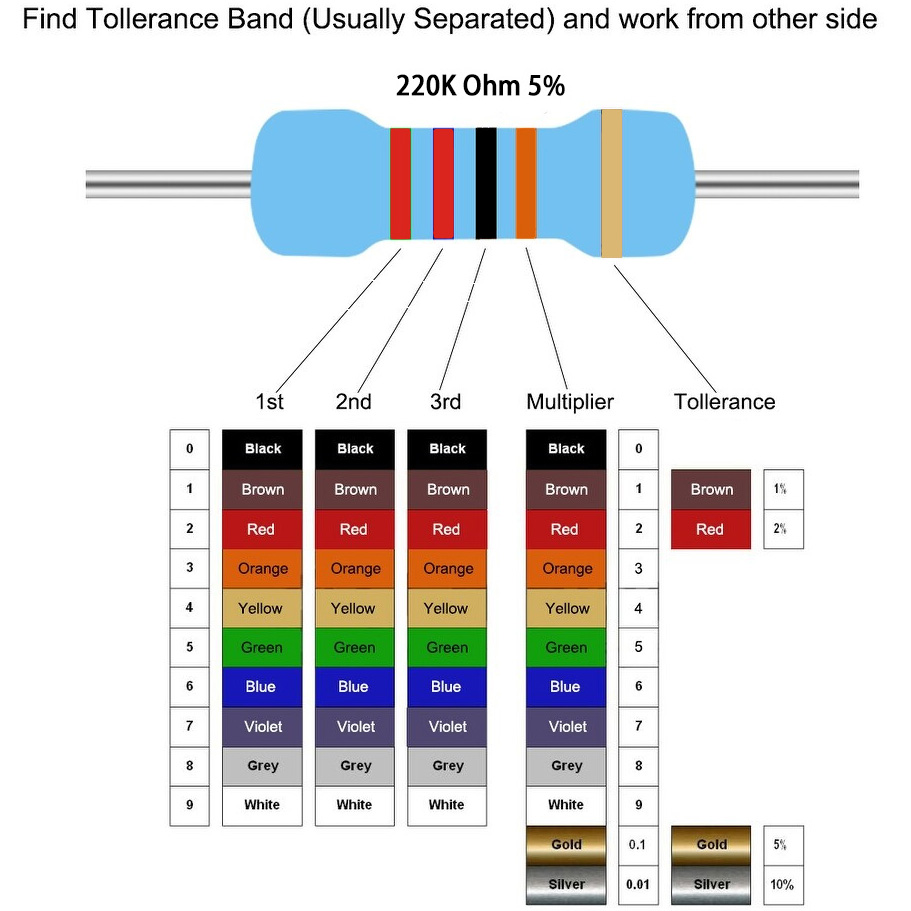
220K ohm Resistor Color Code Chart
These resistors come in different power ratings like quarter-watt(0.25W), half-watt(0.50W), etc., denoting their maximum power dissipation capacity before potential damage occurs. They are available in various types including carbon composition, metal film/oxide film, wirewound among others with each having distinct advantages and disadvantages related to precision/stability/noise/etc., Their applications span across timing circuits in watches/clocks/radios/computers; voltage dividers to reduce voltage levels; pull-up/pull-down resistances in digital logic circuits; and limiting current through LEDs.
Introduce Resistor Color Code
The resistor color code is a system to indicate the value of resistors, which are often too small for numerical values to be printed on them. The most common systems use either four, five or six colored bands.
Here's how you read them:
1. Four-band resistors
First band: first digit (0-9)
Second band: second digit (0-9)
Third band: multiplier (power of ten to multiply the two-digit number formed by the first two bands)
Fourth band: tolerance (+/- percentage variation from the stated resistance)
2. Five-band resistors
First band: first digit (0-9)
Second band: second digit (0-9)
Third band: third digit (0-9)
Fourth Band : Multiplier
Fifth Band : Tolerance
3. Six-band resistors:
Add a sixth color for temperature coefficient.
| Color coding is as follows: | For Multipliers: | Tolerance colors are: | Temperature Coefficient Colors are : |
Black = 0 Brown = 1 Red = 2 Orange = 3 Yellow = 4 Green = 5 Blue = 6 Violet=7 Gray=8 White=9
| Black=x1, Brown=x10, Red=x100, Orange=x1k, Yellow=x10k, Green=x100k , Blue=x1M , Gold= x0.1 , and Silver= x0.01
| Gold ±5% Silver ±10% None ±20%
| Brown :100 ppm/K Red :50 ppm/K Orange :15 ppm/K Yellow :25 ppm/K
|
How to Read 220k Ohm Resistor Color Code
Reading resistor color codes can seem daunting at first, but with a little practice, it becomes quite straightforward. Here's how you can read the color code for a 220kΩ (kilohm) resistor.
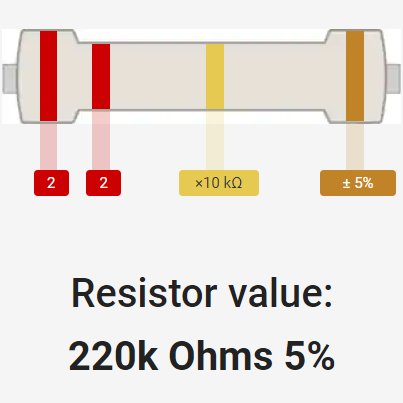
4 band 220k resistor color code
Resistors usually have four or five bands. The first two or three bands represent significant figures, the next band represents a multiplier, and the last band indicates tolerance. Let's break down each of these components:
First Band (Significant Figure): This is the first digit of the resistance value. For a 220kΩ resistor, this would be '2', which corresponds to Red.
Second Band (Significant Figure): This is the second digit of our resistance value - another '2' in our case - also represented by Red.
Third Band (Multiplier): Now we need to account for those trailing zeros in '220000'. In our case, we have four zeros following '22', which corresponds to Yellow on standard charts where Yellow signifies multiplying by 104 or simply adding four zeroes after your significant figures.
So far we've got: Red-Red-Yellow – translating into "22" followed by "0000", giving us "220000" ohms or more commonly known as "220K".
Fourth Band (Tolerance): The final band typically varies depending upon manufacturing standards but it's often gold or silver representing ±5% and ±10% respectively indicating how much actual resistance could vary from stated value due to various factors including temperature changes etc.
Remember that reading these bands generally starts from one end towards another without any gaps between them; orientation matters! If there's some confusion about where to begin due to similar looking ends, look for any spacing differences between bands as this can often indicate starting points.
In conclusion, understanding how to read color codes on resistors helps not only in identifying their resistance values but also provides insights into their overall characteristics such as tolerance levels and reliability under different conditions.
5 Band 220k Ohm Resistor Color Code
A 5-band resistor color code provides more accuracy than a 4-band one because it includes an additional significant figure. Here's how to read the color code for a 220kΩ (kilohm) resistor with five bands:
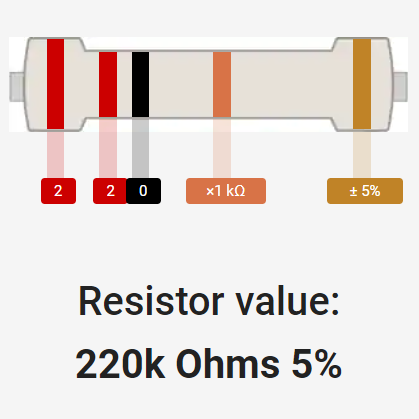
5-band-220k-resistor-color-code
First Band (Significant Figure): This is the first digit of the resistance value. For a 220kΩ resistor, this would be '2', which corresponds to Red.
Second Band (Significant Figure): This is the second digit of our resistance value - another '2' in our case - also represented by Red.
Third Band (Significant Figure): In five band resistors, there's an extra significant figure before we reach multiplier band. For '220K', this third significant figure will be '0' corresponding to Black.
Fourth Band (Multiplier): Now we need to account for those trailing zeros in '220000'. In our case, we have three zeros following "220", which corresponds to Orange on standard charts where Orange signifies multiplying by 103 or simply adding three zeroes after your significant figures.
So far we've got: Red-Red-Black-Orange – translating into "220" followed by "000", giving us "220000" ohms or more commonly known as "220K".
Fifth Band (Tolerance): The final band typically varies depending upon manufacturing standards but it's often gold or silver representing ±5% and ±10% respectively indicating how much actual resistance could vary from stated value due to various factors including temperature changes etc.
6 Band 220k Ohm Resistor Color Code
A 6-band resistor color code provides even more information than the 4 or 5-band codes. The extra band represents the temperature coefficient, which tells how much the resistance of the resistor changes as its temperature changes. Here's how to read a 220kΩ (kilohm) resistor with six bands:
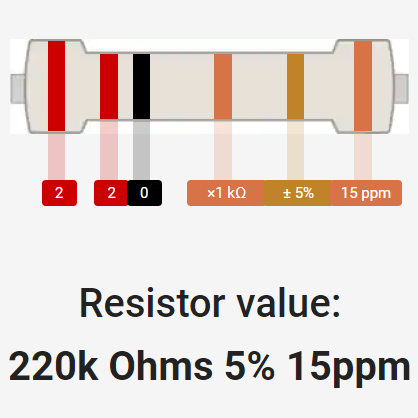
6 band 220k resistor color code
First Band (Significant Figure): This is the first digit of our resistance value - '2' in this case - represented by Red.
Second Band (Significant Figure): This is also '2', and therefore also represented by Red.
Third Band (Significant Figure): For a five or six band resistor, there's an additional significant figure before we reach multiplier band; for '220K', this third significant figure will be '0' corresponding to Black.
Fourth Band (Multiplier): Now we need to account for those trailing zeros in '220000'. In our case, we have three zeros following "220", which corresponds to Orange on standard charts where Orange signifies multiplying by 103 or simply adding three zeroes after your significant figures.
So far we've got: Red-Red-Black-Orange – translating into "220" followed by "000", giving us "220000" ohms or more commonly known as "220K".
Fifth Band (Tolerance): The fifth band indicates tolerance i.e., how close you can expect the actual resistance to be from its nominal value specified via previous bands - typically gold/silver representing ±5% and ±10% respectively.
Sixth Band(Temperature Coefficient): The sixth band indicates how much change occurs in resistance due to temperature variation usually given in ppm/°C(parts per million per degree Celsius). It varies depending upon manufacturing standards but common colors are Brown(100ppm/°C), Red(50ppm/°C), Orange(15ppm/°C), Yellow(25ppm/°C) etc.,
220K Color Code Resistor Collection
For a 4-band 220K Resistor:
Red - Red - Yellow - Brown (±1% Tolerance)
Red - Red - Yellow - Red (±2% Tolerance)
Red - Red - Yellow - Green (±0.5% Tolerance)
Red - Red - Yellow - Blue (±0.25% Tolerance)
Red - Red - Yellow - Violet (±0.1% Tolerance)
Red - Red - Yellow - Grey (±0.05% Tolerance)
Red - Red - Yellow - Gold (±5% Tolerance)
Red - Red - Yellow – Silver (±10% Tolerance)
For a 5-band 220K Resistor:
Red - Red - Black - Orange - Silver (±10 % Tolerance)
Red - Red - Black - Orange - Gold (±5 % Tolerance)
Red - Red - Black - Orange - Brown (±1% Tolerance)
Red - Red - Black - Orange - Red (±2% Tolerance)
Red - Red - Black - Orange - Green (±0.5% Tolerance)
Red - Red - Black - Orange - Blue (±0.25% Tolerance)
Red - Red - Black - Orange - Violet (±0.1 % Tolerance)
For a 6-band 220k Ohm Resistor
Red - Red - Black - Orange - Brown - Black (±1% tolerance, 250 ppm/K)
Red - Red - Black - Orange - Brown - Brown (±1% tolerance, 100 ppm/K)
Red - Red - Black - Orange - Brown - Red (±1% tolerance, 50 ppm/K)
Red - Red - Black - Orange - Brown - Orange (±1% Tolerance, 15ppm/K)
Red - Red - Black - Orange - Brown - Yellow (±1% Tolerance, 25ppm/K)
Red - Red - Black - Orange - Brown - Green (±1% Tolerance, 20ppm/K)
Red - Red - Black - Orange - Brown - Blue (±1% Tolerance, 10ppm/K)
Red - Red - Black - Orange - Brown - Violet (±1% Tolerance, 5ppm/K)
Red - Red - Black - Orange - Brown - Grey (±1% Tolerance, 1ppm/K)
Red - Red - Black - Orange - Gold - Brown (±5% Tolerance, 100ppm/K)
Red - Red - Black - Orange - Gold - RED (±5% Tolerance, 50ppm/K)
Red - Red - Black - Orange - Gold - Orange (±5% tolerance, 15ppm/K)
Red - Red - Black - Orange - Gold - Yellow (±5% tolerance, 25ppm/K)
Summary
The colorful bands on a 220K Ohm resistor are not just for show - they provide vital information about the component's properties and performance in a circuit.
Remember, while our focus has been primarily on the 220k resistor and its specific coding scheme, these principles apply broadly across all types of resistors. So whether it's another type of 220k Ohm resistor or different value altogether, you're well equipped to decode its secrets.
Frequently Asked Questions
1. What color resistor is 220K?
For a 4-band 220k Ohm Resistor: Red - Red - Yellow - [Tolerance](Gold for 5% tolerance and Silver for 10% tolerance).
For a 5-band 220K Ohm Resistor: Red - Red - Black - Orange - [Tolerance](Gold for 5% tolerance and Silver for 10% tolerance).
For a 6-band 220K Ohm Resistor: Red - Red - Black - Orange - [Temperature Coefficient](Yellow(25ppm/°C), Orange(15ppm/°C), Red(50ppm/°C), Brown(100ppm/°C)).
2. What is the current of a 220 ohm resistor?
This depends on applied voltage according to Ohm's Law (I = V ÷ R). You need to know this voltage to calculate current.
3. What is the color code for 200K ohm resistor?
The color codes are:
4 Band Resistor: Red- Black - Yellow - Gold/Silver.
5 Band Resistor: Brown - Black - Black - Orange - Brown(Brown for 1% tolerance).
6 Band Resistor: Brown - Black - Black - Orange - Brown - [Temperature Coefficient](Yellow(25ppm/°C), Orange(15ppm/°C), Red(50ppm/°C), Brown(100ppm/°C)).
4. What is the use of a 220 ohm resistor?
Resistors like this are often used in electronics projects where you need to limit or control electrical current flow, such as when you're using LEDs or other sensitive components that require specific amounts of electricity.
5. Why is it typically best to use a 220 ohm resistor with an LED?
LEDs require controlled amounts of current; too much can damage them quickly while too little makes them dim or unlit at all! A common choice for limiting resistors with LEDs operating around ~20mA and ~2V drop from standard logic levels (~5V).
6. What is the purpose of a 220K resistor?
220K Ohms Resistors are used to control voltage and current levels in an electronic circuit. They can divide voltages, reduce current flow, adjust signal levels, provide bias to active elements, terminate transmission lines among other uses.
7. How do I read the color bands on a resistor?
The color bands on a resistor represent its resistance value and tolerance. For example, for a 220kΩ four-band resistor: Red-Red-Black represents "22" followed by Orange for "Kilo" or three trailing zeros; Gold/Silver typically indicates ±5% or ±10% tolerance.
8. What is power rating in resistors and why does it matter?
Power rating refers to how much electrical power (in watts) the component can handle before potentially getting damaged due to overheating. It's important because using a component beyond its rated capacity may lead to failure.
9. Why do we need different types of resistors like carbon composition, metal film/oxide film etc.?
Different types have their own advantages/disadvantages related to precision/stability/noise/etc., Therefore choosing right type based on requirement ensures better performance & longevity of circuits.
10. How does temperature affect the 220K resistance value?
The effect of temperature on a resistor's value is described by its temperature coefficient, which is usually given in parts per million (ppm) per degree Celsius (°C). This indicates how much the resistance changes for each degree change in temperature.
For example, if a 220KΩ resistor has a temperature coefficient of +100 ppm/°C, this means that for every degree Celsius increase in temperature, the resistance will increase by 0.01% or 22 ohms. Conversely, if the same resistor has a negative coefficient of -100 ppm/°C, then its resistance will decrease by 22 ohms for every °C increase.
11. Can I replace two resistors in the circuit with an equivalent 220K Ohm resistor?
That depends on how those two resistors are connected and their respective values.
If they are connected in series (end-to-end), their resistances add up directly: Rtotal = R1 + R2. So if these two resistances add up to approximately 220kΩ when combined like this, you could replace them with one single equivalent resistor.
If they're arranged parallel to each other (1/Rtotal = 1/R1 + 1/R2), replacing both with one single equivalent resistor would not yield exactly same behavior due to different current paths and voltage drops across individual components.